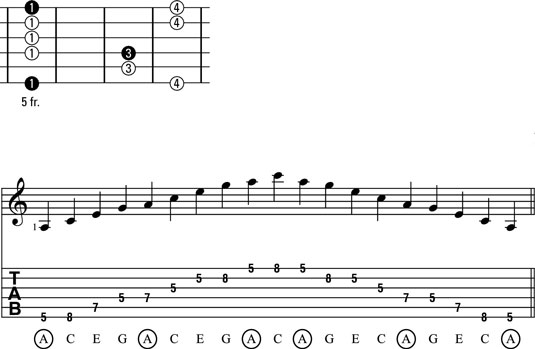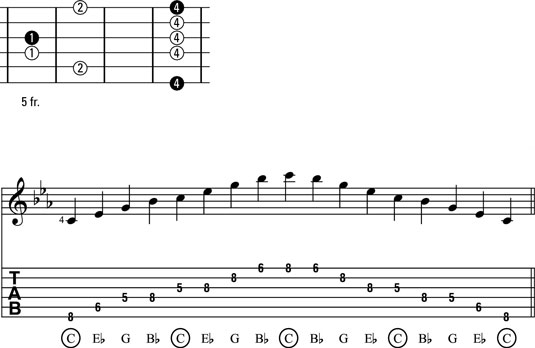A guitar arpeggio is a chord whose notes are played one at a time instead of simultaneously. It’s sort of the exploded view of a chord. Seventh chords sound richer and more complex than basic major and minor chords, and they’re prevalent in many types of music, including jazz, pop, classical, rock, and blues.
Minor seventh chords can be derived in different ways, but one way is to start with a major scale and play 1, b3, 5, b7. So in the key of C, a Cm7 (C minor seven) chord is spelled C, Eb, G, Bb.
Be sure to play each of these arpeggio patterns from low to high slowly, loudly, and deliberately at first. Then play it faster and lighter. Just be sure to maintain your starting tempo and dynamic level throughout the arpeggio.
Minor seventh arpeggio pattern #1
The following figure shows an A minor seventh arpeggio in 5th position in both a neck diagram and in music and tab. There’s just one spot where you may consider a mini-barre substitution for a same-finger hop across two strings: between the 3rd and 2nd strings. Try playing these consecutive 1st-finger-fretted strings as a mini-barre, both ascending and descending.
Before moving on, practice both methods — the 1st-finger hop and the mini-barre — an equal number of times to see which feels more comfortable.

Click here to download and print this arpeggio pattern.
The following exercise is in the key of G minor in 3rd position. A great trick for playing legato passages in minor seventh arpeggio pattern #1 is to barre all six strings with the 1st finger and keep it anchored. Then selectively add the 4th and 3rd fingers where appropriate. This requires a little more flexibility in your hand than if you play all the 1st-finger notes with the fingertip, but it’s a very economical way to play an arpeggio.

Minor seventh arpeggio pattern #2
Because minor seventh chord arpeggio pattern #2 relies heavily on the 4th finger (which is weaker than the others), it isn’t quite as easy to play as pattern #1. As an option, you can flatten your 4th finger to play the consecutive notes on the 3rd and 2nd strings, which occur at the same fret. This is especially helpful if you want to create a more legato sound between the notes.
The neck diagram and corresponding music and tab for minor seventh chord pattern #2 show it in the key of C minor. Practice this pattern using both the written fingering and the mini-barre fingering mentioned in the previous paragraph.

Click here to download and print this arpeggio pattern.
Give this exercise a try. It’s in the key of B minor in 7th position. As with all triplets, accent the first note in each group to help emphasize the three-note groupings. However, remember that because seventh chords have four notes in them, various chord tones rotate (and thus receive the accent) as you play through the sequence.


